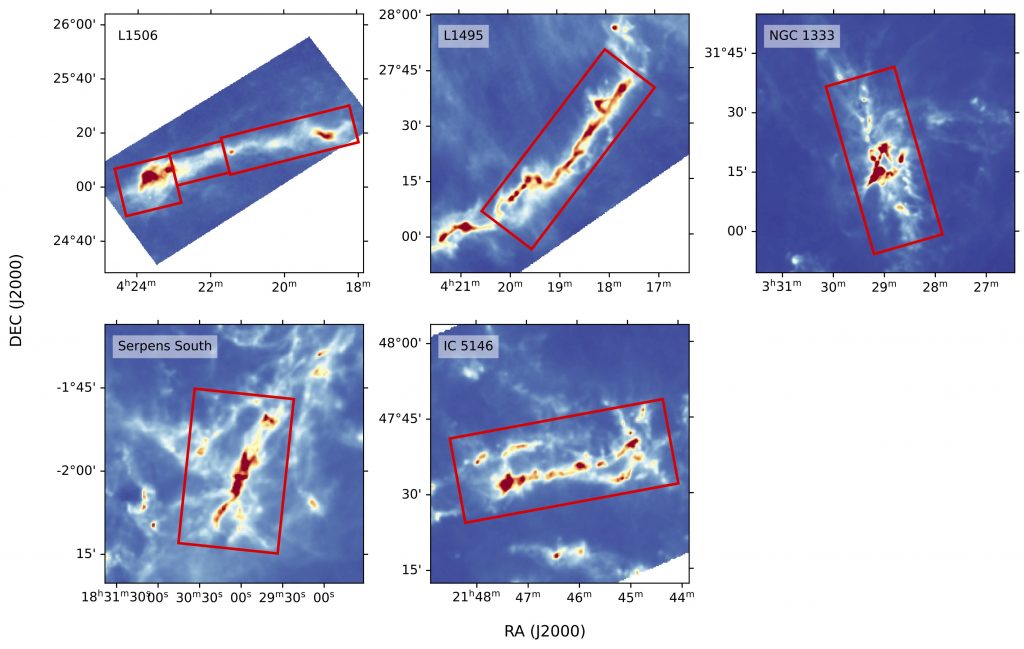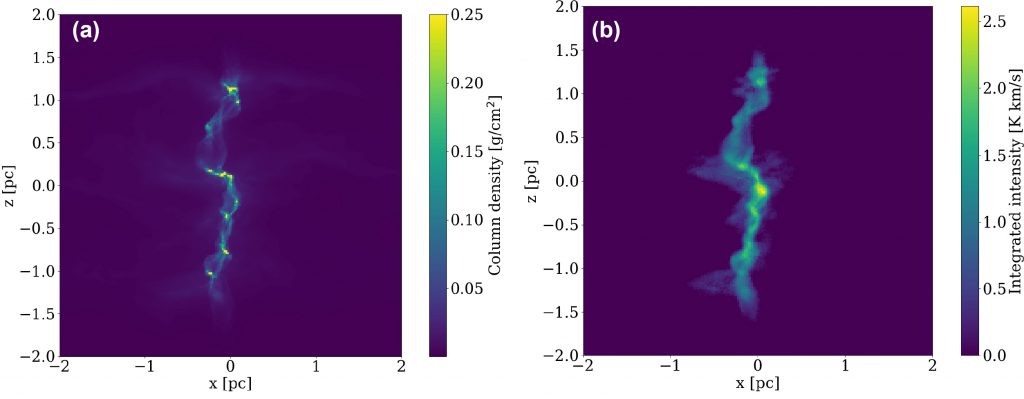Filaments in molecular clouds play a crucial role in assembling diffuse gas into dense, star-forming cores. The details of such a process, however, are not currently well understood. Despite the tremendous progress made with column density studies over the decade, systematic studies of gas kinematic in filaments across various cloud environments are still crucially needed to discern between major star/filament formation models. To address such a knowledge gap, the SURFING survey will establish one of the first systematic kinematic studies of nearby filaments at a higher than 30’’ resolution using intermediate density traces (i.e., C18O and 13CO, J=2-1).
With JCMT’s ʻŪʻū instrument, SURFING will well resolve the commonly reported 0.1 pc filament widths in our targets, which covers five diverse filament networks in four nearby clouds (i.e., Taurus L1506, Taurus L1495, Perseus NGC 1333, Serpens South, and IC 5146; see Figure 1). We selected our targets to sample a highly diverse set of filament networks, ranging from a relatively isolated and straight filament (i.e., L1506) to an active network that prominently features a hub-and-spokes geometry (i.e., Serpens South). The critical mass per unit length values of our samples, as well as the total mass of our target networks, are also selected to cover at least an order of magnitude in values, making the SURFING data ideal for comparing filament properties across various environments, mass regimes, and evolutionary stages.

Herschel-derived H2 column density maps of SURFING’s targets, with the red boxes marking our proposed observing footprints. The color scales for L1506, L1495, NGC 1333, Serpens South, and IC 5146 are each normalized to a maximum value of 0.75, 1, 2, 3, and times 1021 cm−2, respectively.
In our nearer targets, SURFING will also achieve up to a 0.014 pc resolution to spatially resolve sub-filament bundles predicted in simulations (e.g., see Figure 2) and test whether the spectral filament fibers found in lower-resolution studies are indeed physical or if they are merely kinematic features of convergence/accretion flows. With pre-existing complementary NH3 data of our targets (except for L1506) at a 32’’ resolution from the Green Bank Telescope, the SURFING dataset will also enable kinematic and chemical comparisons between the broader CO-detected filaments to the “fertile” denser filaments that harbor NH3 in addition to CO. Moreover, the ability for CO to trace intermediate density gas ambient to denser cores and filaments will be crucial to disentangle core, filament, and their ambient environment from each other, enabling us to investigate the role that converging, accreting, and fragmenting flows play in the mass assembly of filaments and cores, particularly in comparison with synthetic observations of simulations.

Maps of gas column density from a simulation by Clarke et al. (2018) at its native resolution (left) and its synthetic 0.4-pc-resolution C18O integrated intensity counterpart (right). Both images are gridded onto 0.02 pc size pixels.
Coordinators: Mike Chen (Queen’s University, Canada), Tie Liu (SHAO, China), Yoshito Shimajiri (NAOJ, Japan), Sheng-Yuan Liu (ASIAA, Taiwan), Chang Won Lee(KASI, South Korea), Ram Kesh Yadav (Thailand, NARIT), and Doris Arzoumanian (NAOJ, Japan)
– JCMT program code: M22AL005



